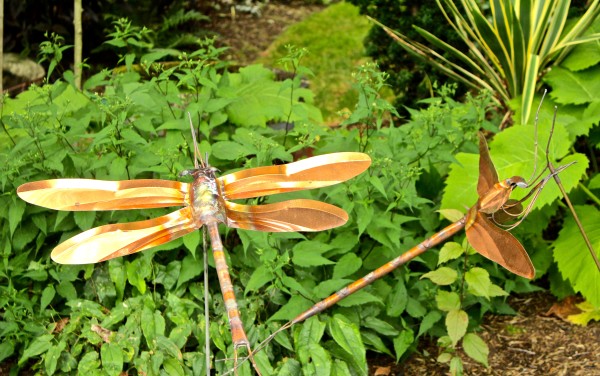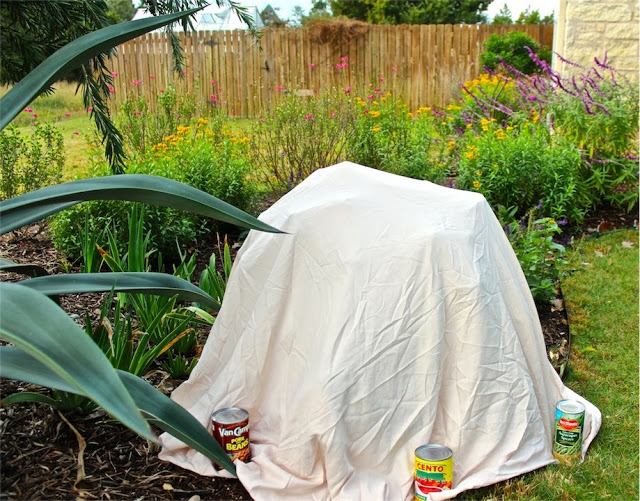Bringing indoor art and style outside

 The current trend to create “rooms” in our gardens is opening doors to incorporating more art into our landscapes. Garden design has taken on a new sophistication in recent years, evolving from the traditional whiskey barrel planters and gnomes of old.
The current trend to create “rooms” in our gardens is opening doors to incorporating more art into our landscapes. Garden design has taken on a new sophistication in recent years, evolving from the traditional whiskey barrel planters and gnomes of old.
Today, art is being used to bring color, texture and contrast into our outdoor rooms. From gazing globes and bottle trees to metal sculptures and pottery, art can add interest and depth to your landscape. How magical it can be when visitors to your garden discover a small sculpture or stepping stone slipped in among your flowers and foliage. Or when you can draw them down a garden path to a beautiful gazing ball.
 You probably shop around to find just the right painting or pottery for that special place in your home. Now, the popularity of indoor decorating with items from nature also carries over and makes that possible in the garden. Home stores like Pier 1, World Market, Home Goods and other larger retailers are adding outdoor-themed decor to their shelves. Stone or ceramic irds, iron scrollwork and small statues have become staples, available for both indoor and outdoor use. A variety of stores also offer all-weather paintings that can brighten up a fence or front porch. A few carefully-selected items and you can add a new twist to your garden rooms.
You probably shop around to find just the right painting or pottery for that special place in your home. Now, the popularity of indoor decorating with items from nature also carries over and makes that possible in the garden. Home stores like Pier 1, World Market, Home Goods and other larger retailers are adding outdoor-themed decor to their shelves. Stone or ceramic irds, iron scrollwork and small statues have become staples, available for both indoor and outdoor use. A variety of stores also offer all-weather paintings that can brighten up a fence or front porch. A few carefully-selected items and you can add a new twist to your garden rooms.
Gardeners are always looking for ways to extend the color in their landscapes as the seasons change. Colorful art in the garden can also add a pop of interest when plants lose their blooms or go dormant. A bright blue bottle tree will brighten up a brown winter landscape.
Bringing art into our landscapes is also another tool in the raging battle against the drought. Replacing grass or beds with hardscapes and art creates new focal points – focal points that don’t need to be watered.
How to find the right art for your garden, style and budget.
Sometimes finding the right accent for your garden is as simple as bringing your indoor decor outside. Perhaps you have some lovely metal lanterns or candleholders on your bookcase – a few more placed on your porch can create a cohesive feel.
Think about your personal style and think about traditionally-indoor home decor items for use outdoors if they are weatherproof or can be placed in a protected area. You may want to find a place for something that’s special to you, or you might want to find something for a special place in your garden.
 Consider areas in the garden that might need a special focal point or sprucing up. And think about the point of view – do you want something to see when you look out your kitchen window or from the couch? Or do you want to place a little treasure in some secret spot in the garden to surprise visitors to the garden?
Consider areas in the garden that might need a special focal point or sprucing up. And think about the point of view – do you want something to see when you look out your kitchen window or from the couch? Or do you want to place a little treasure in some secret spot in the garden to surprise visitors to the garden?
Be sure to choose an item or items that match the scale of your garden – a grand, life-sized sculpture might overpower a small cottage garden. Something too small could get lost, so think about the right balance for your space.
And, finally, art in the garden is intended to be the finishing touch. Don’t overdo it – the objective is not clutter, but creating a sense of purpose. People should appreciate your garden, not your “stuff.”
Your choices should compliment your garden design and your personal style, and, most of all, make you happy.

 It is that time of year, when we play chicken with Mother Nature. Will it really get that cold? Am I in a little pocket that’s warmer/colder/somehow different than the forecast? Whenever winter arrives, there are many things you can do protect plants from frosts or freezes.
It is that time of year, when we play chicken with Mother Nature. Will it really get that cold? Am I in a little pocket that’s warmer/colder/somehow different than the forecast? Whenever winter arrives, there are many things you can do protect plants from frosts or freezes.




